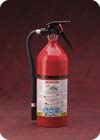Elevate ‘Workhorse’ Extinguishers

A fire extinguisher, big enough and well placed, can diminish the chance of a workplace fire spreading. Employees need training, of course.
There is a long and tragic history of workplace fires. Of course, Occupational Safety and Health Administration (OSHA) standards require employers to provide proper exits, fire fighting equipment and employee training to prevent fire deaths and injuries in the workplace.
Many natural disasters, such as earthquakes, hurricanes and tornadoes, can cause devastation and take a tragic toll. One issue continuously recognized at a time of a natural disaster centers on reports of fires with little or no water supply to extinguish them. Buildings can be engulfed in flames with no method of extinguishment – no water supply, no access to the building and no crews in the immediate area when rescue teams might be stretched to the limits. The reality is that each fire started as one single flame and may have been prevented or contained if a fire extinguisher was available or on the scene in the early stages.
Now, more important than ever, it is critical to ensure that each workplace building has a full complement of the proper type of fire extinguisher for the fire hazards involved.
Security, life safety, plant and building managers must make available the appropriate fire extinguishers at all code-required locations. Managers are also responsible for knowing the codes and exceeding them if necessary to ensure adequate protection of employees and all building occupants.
OSHA requires that employers who expect their employees to use fire extinguishers also provide fire extinguisher training. Employees must be educated and trained on how to use a fire extinguisher and on when is the best situation to use one. The fire department must be called first and make sure everyone is safe.
One important educational resource on fire extinguishers is a public service Web site www.fireextinguisher.com. It provides a thorough overview of the types of fires and types of extinguishers, and allows visitors to point and click their way toward extinguishing a fire. A certificate at the end enables employees to show that they completed this preliminary awareness program designed to help save lives and protect property.
Fire extinguishers require regular maintenance to ensure effectiveness. Only UL-approved and listed extinguishers are recommended; these units must be up-to-date and regularly maintained to provide effective protection from a small, contained fire.
Managers should check the inspection tag and the pressure gauge to make sure it is pressurized and inspected regularly by the employer and fire safety professionals.

There’s a chain for survival when it comes to workplace fires. It starts with a call to first responders but a second step may include a fire extinguisher or standpipe. Also important: signage, lighting and voice evacuation annuncements. Click image for a larger view.
A balanced plan
A balanced fire protection plan in the workplace is made up of several components: fire extinguishers, standpipe fire hose stations, smoke/fire alarms, exit signs, emergency lighting and pre-engineered fire suppression systems. All of these components must be in place and well maintained to make a difference in cases of fire.Fire protection equipment is legislated by city, state and federal laws, many of them directly adopted or adapted from model code-making organizations such as the International Code Council and the National Fire Protection Association.
Building owners must comply with the fire codes of their area. However, they may want to evaluate their balanced fire protection plan and exceed the requirements of local codes for added protection. Businesses, too, should become advocates for their employees’ safety by urging building owners to go above and beyond local requirements for extra precautionary measures.
When it comes to saving lives and protecting property, portable fire extinguishers at work helps security and building managers prepare for potential disasters. One very basic and important premise to remember: While code requirements may exist, it is important that everyone rethink the availability and the placement of extinguishers that are currently available to provide visitors, employees, guests and others with more than enough protection from a fire in the early stages.
Preparedness is the key and a fire protection program that includes portable fire extinguishers has the potential to save many lives and protect valued property. V
SIDEBAR: By the Numbers
Fire safety at work is a critical issue that needs to be continuously at the forefront of everyone’s mind. According to National Safety Council figures, losses due to workplace fires in 1991 totaled $2.1 billion. Of the 4,200 persons who lost their lives due to fires in 1991, the council estimates 327 were workplace deaths. Fires and burns accounted for 3.3 percent of all occupational fatalities.A balanced fire protection plan is the first line of defense against fire. Small fires in the beginning stage can be suppressed with portable fire extinguishers. Even if the occupants are unable to extinguish the fire, they are able to gain time and protect the exit way in order to evacuate or defend in place, while waiting for the fire department to respond.
Here are some facts to consider. When fires are extinguished in the early stages:
- Loss of life is minimal; 93 percent of all fire-related deaths occur once the fire has progressed beyond the early stages.
- Direct property damage is minimal; 95 percent of all direct property damage occurs once the fire has progressed beyond the early stages.
Looking for a reprint of this article?
From high-res PDFs to custom plaques, order your copy today!




